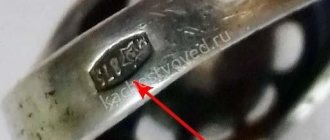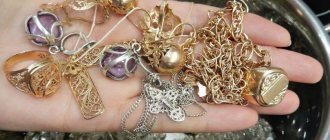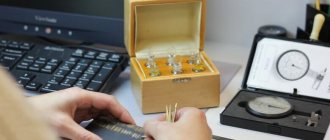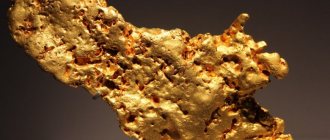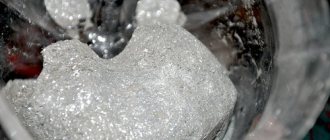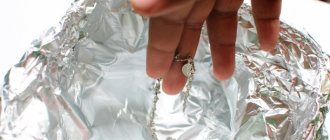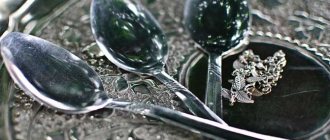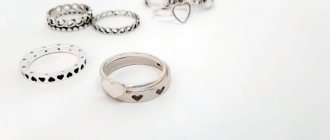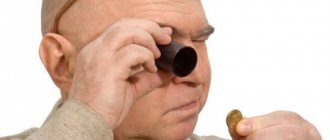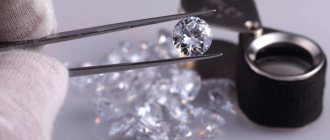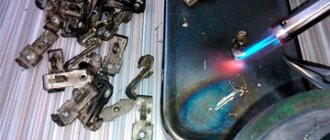Not only jewelry, but also cutlery and interior items can be made from silver.
There is also another type of precious metal - technical. It is widely used in industry and production process. The quality of silver is determined by its breakdown. The sample indicates how much metal is contained in 1 kg of alloy. Thus, in the manufacture of jewelry, spoons and other utensils, silver of the 875, 916, 925 standard is used as a basis. The technical metal is very different - the standard is always 999, and the material itself is extremely plastic and bends easily.
Why know how to test technical silver?
They have learned to make fake silver so professionally that without certain knowledge it is difficult to distinguish it from a precious metal. To prevent a fraudster from profiting from the buyer’s gullibility, experts recommend checking the authenticity at home using improvised means, especially since everyone has them.
Of course, a visual assessment is carried out in a jewelry store or when concluding a transaction with a friend. However, do not forget that the surface layer may indeed be silver. But this does not mean that ordinary stainless steel is not hidden underneath.
What kind of silver is this
Strictly speaking, there is no such type of silver as “technical”. This is the name given to any silver alloy used not in jewelry, but in production.
Composition and properties
The main alloying component in a jewelry alloy is copper. The technical range is wider: cadmium, zinc, tin, nickel, and aluminum may be present. Their proportions are calculated based on the desired result.
Cadmium, zinc and tin lower the melting point, which makes alloys containing them valuable solders. True, cadmium makes the product more expensive, and zinc negatively affects its strength, so there are no universal solders - the composition is selected individually for the task.
Methods for determining silver in a store
What the jewelry is made of can be determined with an accuracy of up to 80% when purchasing the product. Squeeze the thing in your hand and wait for it to warm up. Precious metal always weighs a lot, aluminum, on the contrary, is as light as feathers. Therefore, if in front of you there is supposedly a silver spoon, but it weighs suspiciously little, then your fears are not in vain. Don't overpay for a fake.
Also inspect the product. If zinc is hidden inside, a noticeable dark coating will remain on your hands. Inspect the surface of the decoration inside. If a precious metal is present, it is always stamped with a breakdown. The stamp has clear boundaries and the numbers are clearly visible. The stamp with the hallmark is located clearly in the middle, the same distance is maintained from one and the other edge.
How to determine authenticity
The composition of a part or coating is determined by GOSTs. But there are no such concepts as “genuine” and “fake” technical silver - for two reasons:
- For each purpose, a different alloy is selected. Impurities in it change the properties of the base, and “purer” does not always mean “better” here.
- It is not economically feasible to counterfeit the precious metal used in microcircuits and switches.
If you accidentally come across a homemade “technical” ingot and are wondering if it is silver, try using a magnet on it (a high-grade alloy will not be attracted) or rubbing it in your hand with chalk (the chalk should darken).
Household methods for determining technical silver
If you managed to bring the silver jewelry home, the following simple tests will help determine its authenticity:
- Magnet application, using a rare earth neodymium magnet piece. Silver is not supplied to the magnet. The same test is also suitable for identifying a silver bar. The ingot is held at an angle of 45 degrees, a magnetic piece is placed on top, making sure that it does not end up at the bottom. If the magnet is delayed, most likely the standard of the bar is not as stated, and it is not worth the money the seller is asking for.
- If you need to check the condition of the coins, take 1 ice cube and place it on the coin. See exactly how the ice melts. Silver is distinguished by high thermal conductivity. If the precious metal is of high standard, the ice piece will melt in just 3-5 seconds.
- If you have iodine on hand, apply it to the product carefully, preferably pointwise, so that it does not stain the item. Dark spots will appear on the original metal.
- Buy sulfur ointment at your nearest pharmacy. Then go over the test piece with sandpaper and apply a small amount of sulfur ointment to the area. Leave the product for 15 minutes. Next, evaluate the appearance of the treated area. If a stain is present, the jewelry is real. In other cases, the stain will not appear.
- Take a lapis pencil. Moisten the thing and leave a stroke with a pencil. If the mark turns a different color, this is a fake.
Where is it contained?
Technical alloys are used to create much of what we use every day. If you are reading this article at work, look around and look at the office equipment - there is silver in every device and microcircuit. One power supply contains 1.5 g.
The more modern the device, the less precious metals it contains and, accordingly, the more difficult it is to extract them.
The state controls the disposal of equipment not only for reasons of environmental safety, but also to reduce the loss of precious metals during processing. Only licensed organizations can accept high-tech scrap containing precious metals from the population—for example, there are several dozen of these in Moscow.
Simple methods for determining technical silver
Simplified options on how to independently determine technical silver can be read on the Internet:
- Rub the decoration thoroughly with a piece of chalk. If dark lines appear on the chalk from a silver-plated item, this means the item is made of precious metal.
- The definition of commercial silver includes the use of boiling water. The product is immersed in a glass of boiling water for only 2 seconds, and then taken out. Silver jewelry will instantly become hot, but fake jewelry will not.
- Scratch the decoration with a thin needle. Do not be afraid to damage the product; if it is made of silver, there will be no marks from the needle.
- You can simply rub the product with sandpaper. The top layer will be cleared, what is underneath will become clear immediately.
Useful impurities in alloys
But don’t be upset: pure materials are practically never found in nature. Jewelry is no exception. And no fashionista would want to have jewelry made of pure metal, since an admixture of lead or nickel greatly improves the external and physical parameters of the metal.
Nickel additives add shine to silver products, facilitate processing and, to a certain extent, increase service life. Lead makes the alloy more ductile. And this only applies to the jewelry industry. But silver is used not only for making jewelry (it is widely used in technology). Contacts in radio components, wiring in high-precision technology, coating on photographic film, reflective parts of mirrors - all this is technical silver.
The breadth of use of this metal is due to the fact that it has a number of irreplaceable physical characteristics:
- excellent electrical conductivity;
- purchase at low cost;
- very high level of thermal conductivity;
- low melting point, which makes the smelting process relatively inexpensive;
- under the influence of air, ions do not form on the surface of silver, so there is no need to clean and degrease the surface during repairs;
- The metal is soft and therefore easy to process.
Feel like a chemist
Do you want to continue experimenting? Every self-respecting jewelry store sells a kit for performing a chemical test. Before you begin unsealing reagents and chemicals, you should wear gloves. How is testing carried out?
- Scratch the product.
- Spread the acid over this area.
To correctly interpret test results, please read the instructions. The precious metal under the felting of chemical compounds will turn bright red. If there is a blue or brown tint, then silver is out of the question.
One of the ways to determine technical silver is clearly shown in the video:
If there is no opportunity or desire to test a product for “purity,” buy jewelry in trusted jewelry stores and avoid private traders who offer expensive goods at a cheap price.
Lead removal and electrolysis
But the cost of technical silver also depends on the type of impurity. The easiest way to clean it is from lead (the density of which is much higher, and the heat of fusion is very low). Regular melting of the alloy will allow you to easily separate it into fractions. It will be more difficult to clean silver from copper impurities.
This alloy (it used to be very fashionable to make cutlery from it) is popular among the population, but it is purchased with great reluctance. This is not limited to ordinary remelting; it will be necessary to keep the metal in a molten state for a long time (preferably at high pressure). Cleanup costs will be higher.
In the recent past, almost all amateur photographers isolated technical silver from waste reagents by electrolysis. There was no mass purchase of such metal, but jewelry workshops used it to make solder. Jewelers knew this composition of technical silver, so the price per gram of metal was fixed.
Peculiarities
This metal is used in the manufacture of wires for various purposes, electrical circuits, solders, batteries and other structures. To get money for turning in silver, you can sell capacitors, resistors, switches and other electrical components containing it. Such elements are made from alloys of pure silver with various metals: it can be cadmium, zinc, lead, tin, aluminum or other material. When creating a technical alloy, iron is not used because it does not combine with silver particles.
The degree of strength of technical raw materials depends on the composition of additives and their ratio. In the manufacture of contact pairs, buttons, and switches, mechanical silver is usually used, the purity of which does not exceed 65%. If you calculate the parameter according to the generally accepted classification, then such a metal will correspond to 600 or 650 samples. It is classified as low-grade for the introduction of ligatures that affect magnetic properties. There is also non-magnetic silver, the purity of which is almost 875. It is more in demand, therefore, among companies that accept precious metals, radio components with such a composition are accepted on more favorable terms. For the manufacture of solders, silver alloys corresponding to 400-700 standard are used.
Where is it used?
Technical silver has a number of physical and chemical characteristics that make it suitable for use in the manufacture of radio equipment. As mentioned above, the level of impurities in the metal is almost zero, however, to improve its utilization, nickel, copper, lead, etc. are added. This element is widely used in the production of solders.
The most famous copper/silver tandem is used to create all kinds of radio components, equipment for electronic equipment, as well as for electrical breaking moving contacts.
In the event that the amount of silver dominates, then such a connection is strong and anti-corrosion . With a high copper content, it can be subject to deformation and destruction. The alloy of palladium with a commercial metal is significantly superior to the example above. Due to the presence of sulfur in their compound, it is characterized by resistance to corrosion and less susceptibility to distortion.
Compound
An important feature of technical silver is the high level of purity of the alloy – 99.9% . In this case, the amount of all kinds of impurities is equal to 0.1%. But it should be noted that, unlike jewelry silver, the main function of this metal is not aesthetics, but its importance for the manufacture of radio equipment.
It is the purity of the metal that is the basis for good thermal and electrical conductivity, which makes this element important in industry.
Considering this insignificant percentage of impurities, we note the main components: nickel, copper, gold, etc. Most often , 999 purity is used on pure metal, but if it contains more than 10% copper, then the purity will already be 800. And with a high content, the metal may acquire a yellowish tint, but at the same time it becomes much stronger.
A hallmark of 830 indicates that there are 170 grams of impurities, and the remaining 830 grams is silver itself. This metal is used mainly for decorative purposes (when creating various jewelry or accessories). This element is widely used in the manufacture of household utensils (silver glasses, cups, spoons, forks, etc.).
It is characterized by fairly high strength and resistance to all kinds of physical damage.
875 silver is a white alloy and is still not suitable for jewelry. Most often used in bracelet and watch cases. The amount of additives in this metal limits its susceptibility to any physical damage.
As you know, 925 silver products are ideal for creating jewelry. The metal contains silver and copper in the following proportions: 92.5% and 7.5%, respectively.
Well, the composition of technical silver is characterized by the highest purity of the metal and the virtual absence of impurities . It is these parts that are flexible and soft, and therefore are of great importance in the manufacture of radio engineering devices.
Where can you buy or sell
There are organizations involved in purchasing, including technical silver, online auctions, and pawnshops. Most of them operate illegally (without a license), and an attempt to sell independently mined silver may come to the attention of the Department for Combating Economic Crimes (OBEP).
How much does 1 gram of tech cost? silver for today
The value of silver on the world market is rising and today it is considered a good investment. A chart will help you track price fluctuations.
| Price 999 standard according to the Central Bank | Market value of the sample today | Scrap price | Price in jewelry |
